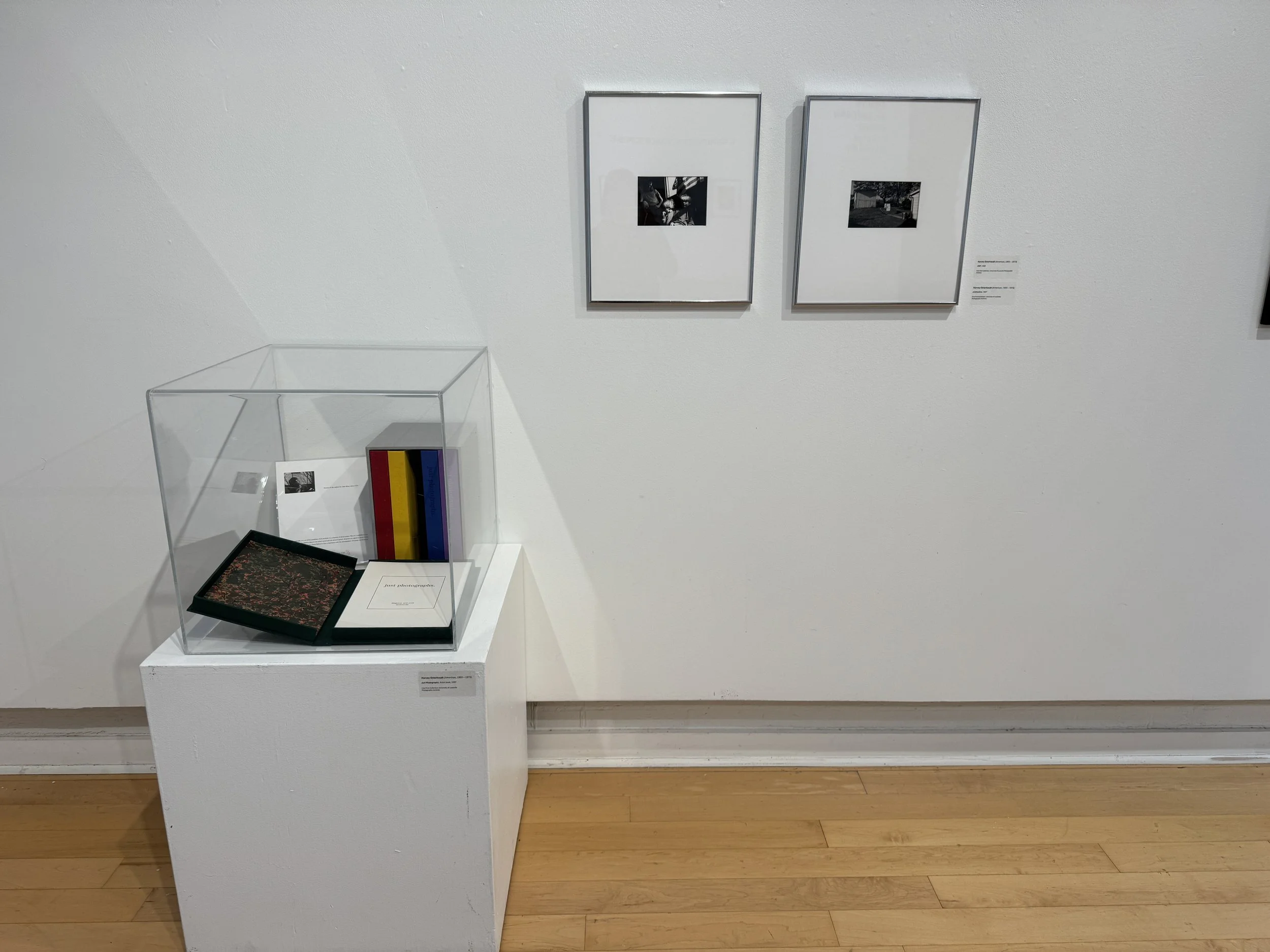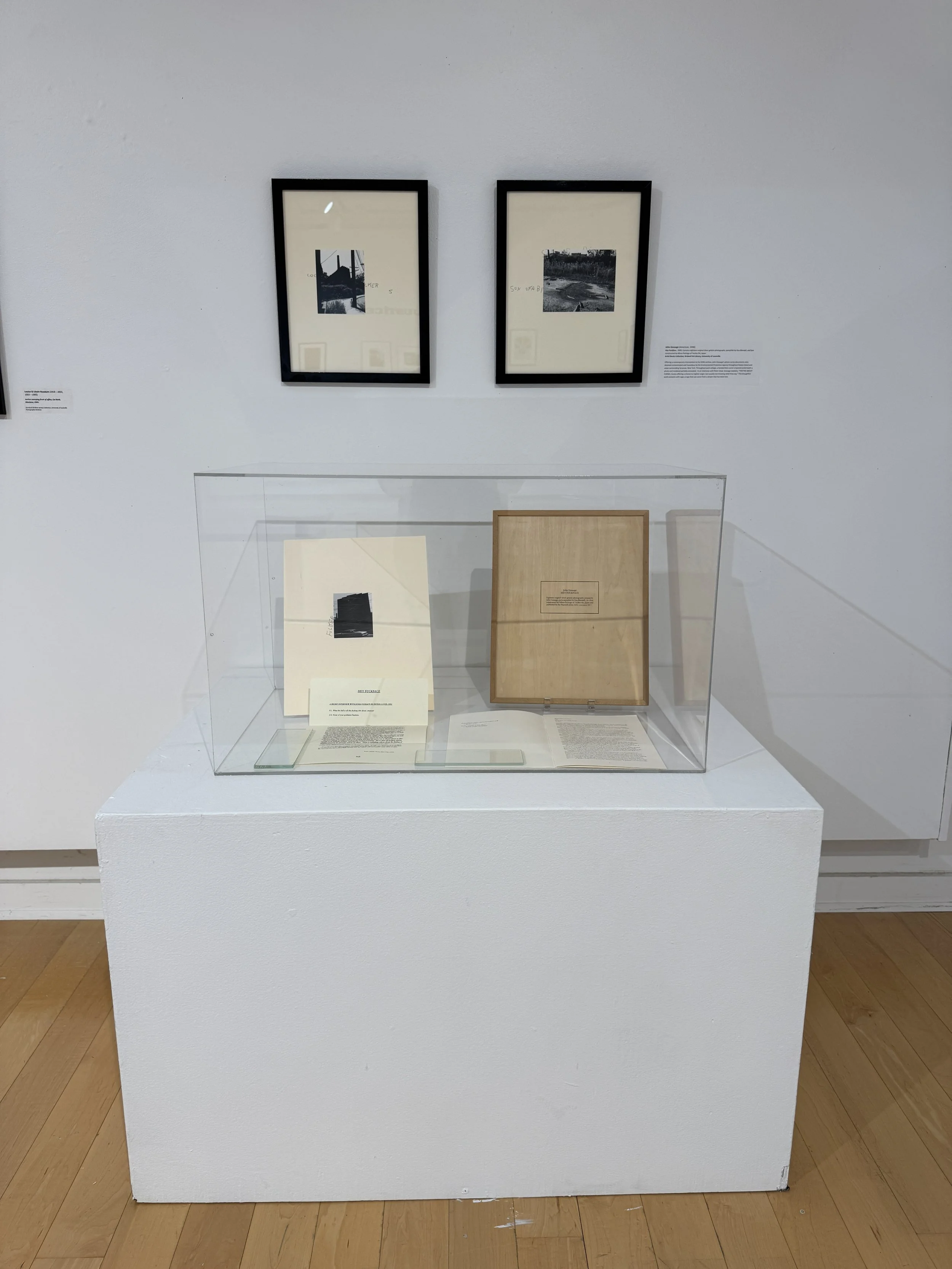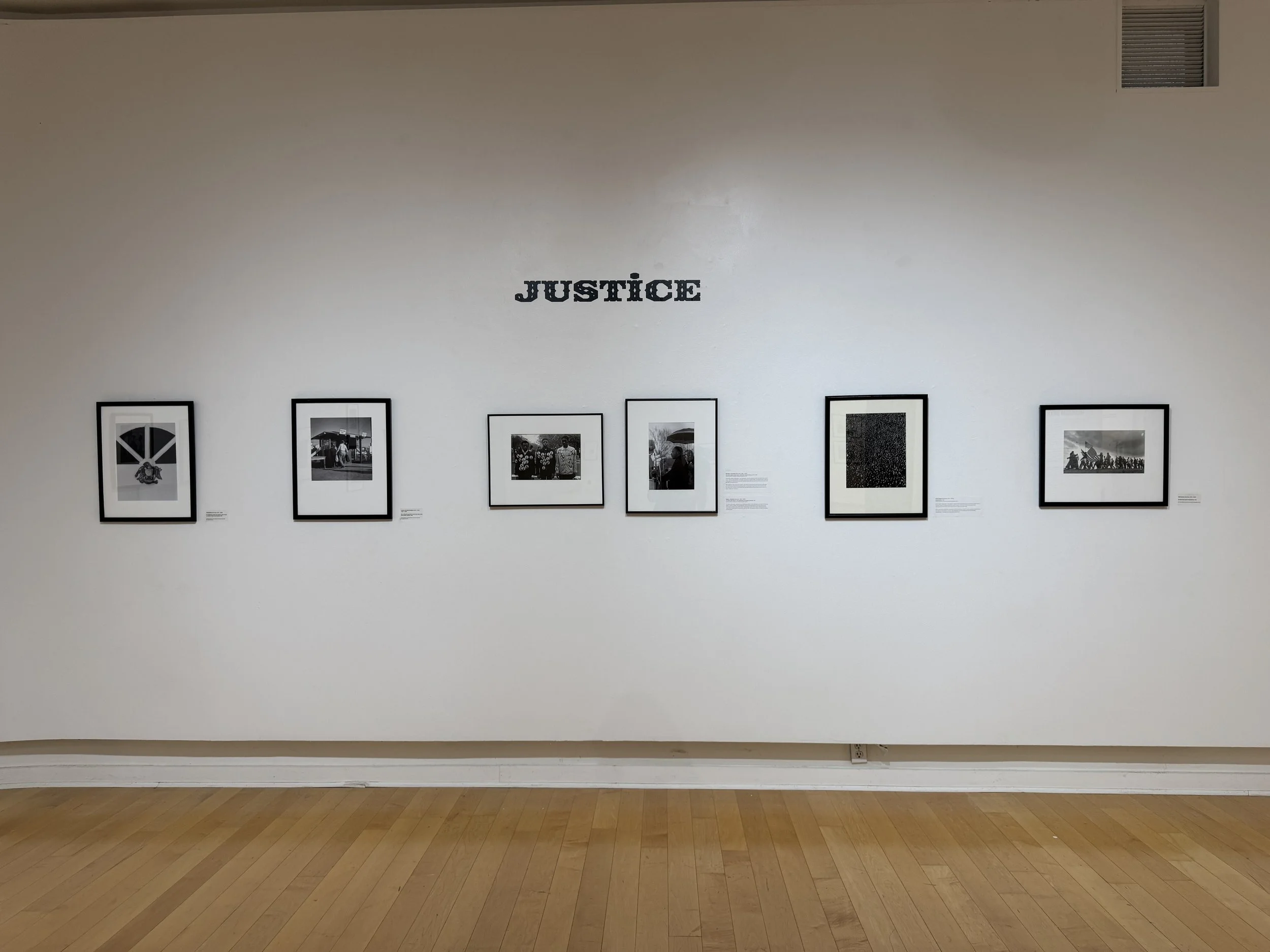Doing Americana: Photography, Mythology, and the American Dream
An interview between Cassidy Meurer and Sarah Melloy on student-led archival exhibition at UofL.
Doing Americana: Photography, Mythology, and the American Dream is a Louisville Photo Biennial exhibition on view in Schneider Hall’s main gallery on UofL’s Belknap Campus from August 28th to October 31st, 2025. This exhibition is the result of eight months of work, beginning in Dr. Jennifer Sichel’s spring semester course, Photography and Curating, and continued over the summer months.
This student-led exhibition was curated from two photograph collections in Archives & Special Collections (ASC) at UofL. The first is the Standard Oil New Jersey (SONJ) collection, depicting life through the lens of the massive oil corporation both across the United States and internationally. Directed by Roy Stryker in the 1940s and 50s, this 26,000 item collection provided the foundation for Doing Americana. The second collection mined for this exhibition is ASC’s Fine Prints collection, a large composite collection containing original artists prints. Originally constructed as a teaching collection, the Fine Prints include nearly every subject and photo process imaginable.
I had the immense privilege of sitting down with Sarah Melloy, one of the head curators of Doing Americana. It was exciting to reflect with Sarah about her and her classmates’ hard work after its completion. Read our conversation below:
- Cassidy Meurer
Cassidy Meurer [CM]: This exhibition is titled Doing Americana: Photography, Mythology, and the American Dream. What does that title - Doing Americana - mean to you?
Sarah Melloy [SM]: For me, I think about Americana as an aesthetic treatment of the American Dream. Little picture-scapes that you would think of as generally American. Like canned jams and roadside attractions, those little things that are specific to the U.S. The “doing” part came from a quote from Roy Stryker when he was instructing the photographers for the Standard Oil New Jersey project. He said, “Do your oil stuff. You’re doing Americana, just take everything in sight and shoot it.” So, we used those ideas together to create the title.
CM: What did it mean to curate this exhibition in such a collaborative way? Did the classroom setting create limitations or provide helpful parameters for thinking through your curatorial decisions?
SM: It did both! We had many people with differing backgrounds, so we needed a subject or curatorial aim that was both broad and specific enough that 14 students could write about it in a cohesive way. The hardest part was probably getting the object checklist together, getting 14 different points of view of what Americana or the American Dream is, into something that will fit in a gallery.
One thing that helped a lot was having some digital organization for the class as a way to make sense of our thoughts and research. It was also incredibly helpful to work with processed collections that are on the archives’ Digital Collections website. Online access to the SONJ photos allowed more options for students than the typical visit to the research room, which can be hard to find time to do. We also received a Finding Aid for the Fine Prints collection that contained thumbnails, so having the photographs in a digital format made everything more accessible. It allowed us to do better research to create a better show.
CM: I’m curious, when you were talking about your idea of the American Dream—we all have slightly different perspectives on that. How did you navigate distilling all of these different perspectives of the American Dream into something coherent?
SM: It was tough, but it helped us understand each other more. I think a lot of us are really disillusioned with the idea. Many of us came into this class not believing in the American Dream or not believing in its effectiveness. But on the other hand, one student, who is a first-generation American, said that her parents talked about the American Dream all the time. For them, it’s the suburban creature comforts, like the ability to take a long, hot shower. That’s something that you can take for granted. So, we took everyone’s ideas and tried to organize the show around them. We ended up using the preamble to the Constitution to create our categories: Justice, Common Defense, Blessings of Liberty, General Welfare, and Domestic Tranquility.
CM: The Constitution preamble works so well because it is pulling from this guiding document that is meant to proclaim who the United States is, and you’re turning the record against itself, using it to illustrate all the ways that it fails. It’s really so brilliant.
SM: Something we had in mind while curating the show was this disconnect that’s always been there—what’s happening at the government level, officially, versus what’s actually happening with the people, and where those values break off.
CM: So, notating the different sections of the exhibition as those parts of the Constitution's preamble created a structure for you all to work within. Was that how you decided to collectively land on one definition of Americana, which guided how you looked through the archival photographs?
SM: Yeah, it started pretty unwieldy, and then those five categories became our sort of guides while looking for the “American Dream” in the collections. It actually started as someone using it kind of as a joke, but then our professor said, “No, that’s good, that’s really smart, we can use that.”
CM: Did you feel that Dr. Sichel’s role as a third-party figure, who was also invested in the exhibit but without the same stakes, was necessary in curating within a class setting?
SM: Definitely. It was really good to have, especially on days when we were going through everyone’s contributions and deciding if we wanted to keep or cut things. Having an authority figure in the room to hear us out, but still make an executive decision in the moment, helped a lot to keep us on schedule. Over the summer, we did make some changes, so there was still flexibility with the checklist after the class ended
CM: I want to talk more about the summer curatorial team. You all did so much work to make this happen over the summer, and I’d love to make clear the labor that is required for putting together such a collaborative exhibition. Could you spell out where things were left at the close of the semester and what was accomplished during the summer months?
SM: So, by the end of the semester, we had a preliminary object checklist for the exhibit. We had the theme, the title, and we had writings from each student in the class: at least one catalog entry and at least one wall label from all of the students on the objects they chose to write about. During the summer, Gray Koesters, Chenoa Buster, and I created a catalog. Gray and Chenoa edited all of the texts, arranged the catalog, and wrote the introduction to the exhibition. I helped with editing and arranging, but designing the catalog was the bulk of that labor for me.
While we were doing that, we were refining the object checklist, and we were thinking about how it’s going to look when it’s actually up on the gallery walls. We had concerns about certain sections having more items than others, or if the items in a section convey what we’re trying to say about domestic tranquility, or general welfare, for example. And making sure that we had a strong definition of these themes. We were also making sure that we had a good balance from both collections, so it didn’t feel like it was a show about one or the other. Locating the original prints, making reproductions of SONJ photos, and matting and framing the works led to installing the exhibition. We planned programming, including the opening reception and coffee talk and tour.
CM: What is it about the SONJ collection and the Fine Print collection that deserves focus and recognition?
SM: For SONJ—it’s such a huge collection that was really influential during its time, in both photography and in popular culture. It’s one of those collections that really shows how photography and advertising have shaped what we think of as Americana, or what we think of as being American, through the staged nature of the photos. They appear natural because the photographers are so technically skilled. That’s a reason to pay more attention to it, especially in our current climate in which we’re bombarded with images all the time, and we should be questioning where they come from, and what the purpose was. The SONJ collection is framed as these documentary photographs, but they are doing a lot more than just documenting.
The Fine Print collection—it’s hard to put into words how amazing it is. Everything in it is a treasure in some way. There are niche areas of photography, really famous photographers, and locally significant artists, all mixed in with lesser-known works. The vastness allows you to work in any way and take it in any direction you want. There’s so much represented there in terms of subject matter and types of photographs. So putting those together was a very fun and challenging exercise.
CM: Do you feel that the materials in these two collections change when put in conversation with one another?
SM: Definitely. The most striking thing about putting the Fine Prints with SONJ is that you could see the influence of SONJ and the idea of Americana in a lot of the American photographers' work. So throughout the show, we have a few pairings of a SONJ image with a Fine Print image that were made decades apart, but they resonate with each other and are kind of saying the same thing through the photo.
CM: Do you think that the inclusion of the Fine Prints in the show encourages a reevaluation of the SONJ images?
SM: Yeah, I think it helps you see the artifice of the SONJ photos, which is not always clear. A lot of people do interact with the SONJ photos at face value, like it is straight documentation.
CM: Can you talk about one of the guiding theoretical texts that helped shape this exhibition? Was there a past exhibition that inspired Doing Americana? In what ways are these influences felt in this exhibition?
SM: Roland Barthes’s Mythologies was a text assigned to us by Dr. Sichel as our guiding framework once we knew we would curate with SONJ. The focus of Mythologies is that ideas are constructed and become myths—an idea that has been made to appear natural to you, but it’s been built up, constructed through media and narrative. In SONJ, we applied this to the way the photographs are literally staged, but made to appear natural. For instance, one SONJ photograph of the nuclear family shows the father reading the newspaper, his son reading something in front of him, the mother sewing on the couch, and the daughter mirroring her, all reinforcing norms around gender roles.
The other theoretical text we used was Cruel Optimism by Lauren Berlant, which talks about the idea of the good life. We often think of it as synonymous with the American Dream. When you are always chasing the good life, it can create a barrier for you to actually have a good life.
CM: Doing Americana feels like an imperative exhibition for our current moment in American history. How did today’s political and social climate affect the curatorial decisions made in this exhibition?
SM: This exhibition is definitely a response to our current political and social climate. We are constantly bombarded with images that contain motives. With this exhibit, we want people to really think about that and remember that the photos they are looking at are constructed, maybe by a photographer, and now maybe by AI. Also, the American Dream has increasingly been weaponized and used by the Trump administration to harm the many, many marginalized groups that don’t fit into their idea of it. So we wanted to go back to how that idea was created in the first place and present a response to it, and show another side of it.
Personally, I was feeling very disillusioned by America in general, to the point where I forgot about the good aspects of it. We are in some ways reclaiming what it means to be an American, and we don’t have to comply or subscribe to the ways this term is used to harm people. Curating this show reminded me that being American can be good.
CM: I love that perspective, it’s not a full stop criticism, but truly a reflection and a response.
Visit Doing Americana: Photography, Mythology, and the American Dream in the Schneider Hall Main Gallery on the University of Louisville’s Belknap Campus through October 31.
This interview has been edited for brevity.





